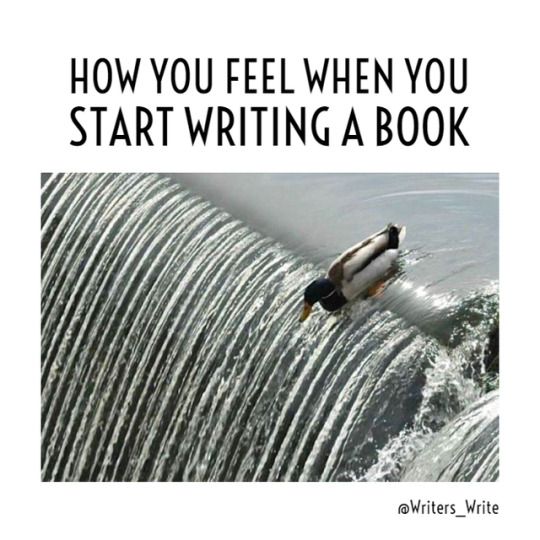Welcome to FMTP blog: On Writing and Editing--the extended version. This blog contains writing and editing advice articles found on my website plus bonus tips and tricks to help you hone your craft and find your voice. If you love reading, writing, or language, you're in the right place. Author and book blog: @dreamwriter12
Don't wanna be here? Send us removal request.
Link
Great tips in here, and a unique perspective!
Hey, I’m on Writers Helping Writers today! 😊 After listening to Brandon Sanderson talk about the importance of having a sense of progress in any story, I recalled these 8 elements that will help you do just that 👍
34 notes
·
View notes
Text
The 15 PLOT POINTS of Story Structure
To all the writers who have ever been told they need to outline their story, and privately thought “Great. But how do you DO that? What exactly does that mean?! Is there a map? WHAT IS THE SPECIFIC DEFINITION OF THE VAGUE WORD ‘OUTLINE’?”
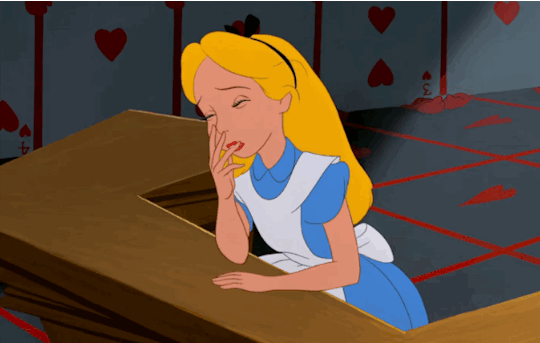
Good news. Stories have structure. Structure that can be learned. And a fantastic place to start learning structure?
Save the Cat: The Last Book on Screenwriting You’ll Ever Need by Blake Snyder. This book gives a simple outline that most stories follow. And as an introduction to story structure, it can’t be beat.

In Save the Cat, 15 plot points are spelled out in something called a beat sheet. During the outlining process, these “beats” or plot points can be used as an armature or skeleton that your story is built upon.
So what are those 15 plot points?
Opening Image: A snapshot of the hero’s problematic ordinary world, right before the story starts and changes everything.
Set-Up: Further establishing that ordinary world and what the hero does every day, impressing upon the audience or reader what’s wrong, and the idea that something needs to change.
Theme Stated: The truth that the hero will learn by experiencing the story, the statement that will be proven to the audience. But upon first encountering this truth, in this story beat right in the beginning, the hero doesn’t understand or outright refuses to believe it. The theme stated is asking a question, a question which the story will answer.
Catalyst: The ordinary world is shattered. Something unexpected happens, and this event triggers all the conflict and change of the whole story. Life will never be the same after this moment. This is the Call to Adventure.
Debate: But for a moment, the hero won’t be quite sure about answering that call. Leaving behind the ordinary world is difficult – even if the catalyst has come along and disrupted everything – because the ordinary means safety, it means not being challenged, it means avoiding conflict and heartache. Yes, that existence they’re stuck in might be stagnant and unpleasant, but it protects them from facing the intimidating task of growth, of becoming something better.
Break Into 2: And this is when the hero decides to answer the call and cross the threshold of act two, determined to pursue their goal.
B Story: This is when the relationship – which usually carries and proves the theme – starts in earnest.
Fun & Games: This is just what it says: the premise promised a certain type of pure entertainment, and this beat is where we get to experience it fully.
Midpoint: This is either a false victory or a false defeat. Something really really good happens. Or something the exact opposite.
Bad Guys Close In: Forces of opposition and conflict begin to converge on the hero and his goal. Everything begins to fall apart for the hero, the defeats piling up one after another, the main character punching back.
All Is Lost: This is the sequence where absolutely everything falls apart for the hero. The plans fail, the goal is lost, the mentor dies, the villain wins. All is, quite literally, lost.
Dark Night of the Soul: The hero’s bleakest moment is right here. In addition to all of the tangible things that have been lost, hope and the gumption to continue with the story have also vanished. There is usually a hint of death here, of some kind. An actual death, or an emotional or spiritual death.
Break into 3: Ah, but there’s a light at the end of the tunnel. Inspiration occurs, hope is rekindled, courage to pursue the story returns. Usually, this is the moment where the main character learns what they NEED, the truth which will heal them, and allow them to fix their own lives. With this, they are able to snatch victory from defeat.
Finale: And in here, the story goal is pursued once more, but this time from the stronger version of the hero – the version that has learned the theme, and committed to act accordingly.
Closing Image: The opposite of the opening image. This is a snapshot of life after the story, the problems of the ordinary world solved or banished, a new world opening up for the hero. If the opening is the equivalent of “once upon a time” this is saying “And every day after … “
So let’s see how that works! And to see it, let’s look at my favorite short film of all time – Paperman (because this gave me an excuse to watch it several times and listen to the music while writing it.)
1) Opening Image
We see George, a twenty-something in a sixty-something’s suit and tie, obviously on his way to work, and not looking at all enthused about it. He stares straight ahead, expression bored, lifeless, right on the edge of depressed. Wind from a passing train pushes him slightly, and he lets it, demeanor unchanging.
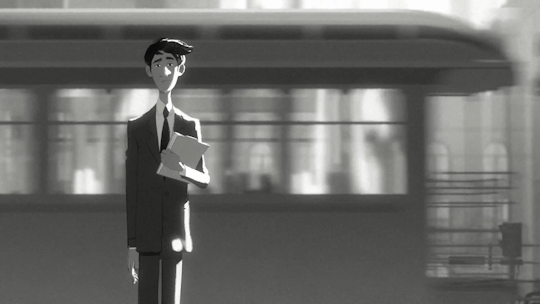
2) Set-Up
But then a sheet of paper, caught on the wind, hits his shoulder. The paper flies off again, and a young woman appears onscreen, chasing after the paper, as the surprised George watches.
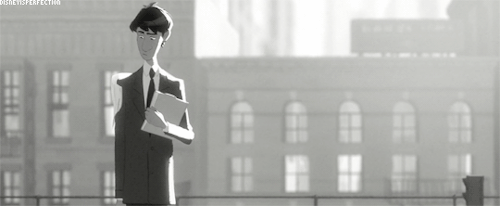
After catching it offscreen, the girl returns, tucking the paper into the stack she carries, smiling slightly. They both face forward, waiting for the train side-by-side, in silence. She’s glancing sideways at him, he’s smiling and fidgeting nervously, but still resolutely facing forward; they’re both aware of each other, seemingly hoping the other will be braver, but neither able to overcome their shyness and the unspoken rules of everyday life.

3) Theme Stated
As a train charges into the station, a paper from George’s stack is snatched by the wind and lands flat on the woman’s face. When he pulls the paper away, she laughs: her lipstick left a perfect kiss mark on the sheet. When George spots it, he laughs too …
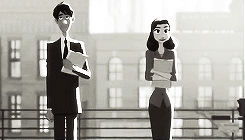
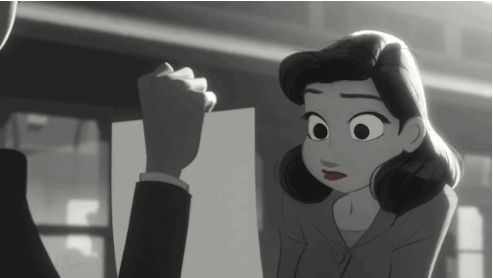
but when he opens his eyes, she’s gone. She’s boarded a different train. The kiss-mark paper flaps in the wind as the train begins to move, taking her away. He watches, crestfallen. She glances back. Looks of regret and disappointment are exchanged, both a little wistful. The paper, the symbol of their fleeting memorable meeting, waves goodbye.
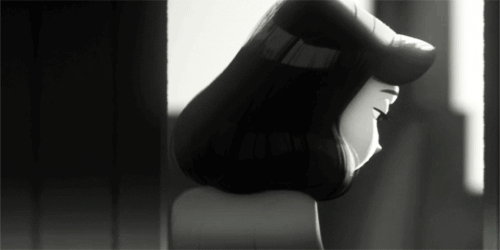
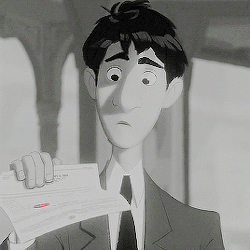
Through this little sequence of images, the question of the whole story is asked: Was there a connection between them? Will they find each other again? And on a wider level: What does it take to find love?
Further Set-Up:
And cut to George behind a desk, in a gray office, dark file cabinets towering behind him, clocks on the wall ticking away his life. Miserable again, he stares at the lipsticked paper. A stack of documents slams onto the desk from on high. The grim-faced boss of the office scowls down at him. George frowns at the stack, then at his boss, who stomps away.
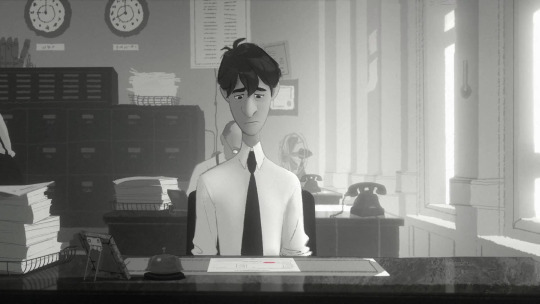

4) Catalyst
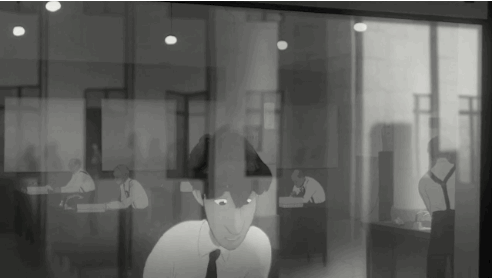
Breeze pulls the kissed paper off his desk and out the open window. He catches it just in time, breathing a sigh of relief. And then he sees something. The girl! She’s there! She’s right across the street!
5) Debate
He needs to get her attention! He dithers for a moment, then throws the window wide and enthusiastically waves his arms.
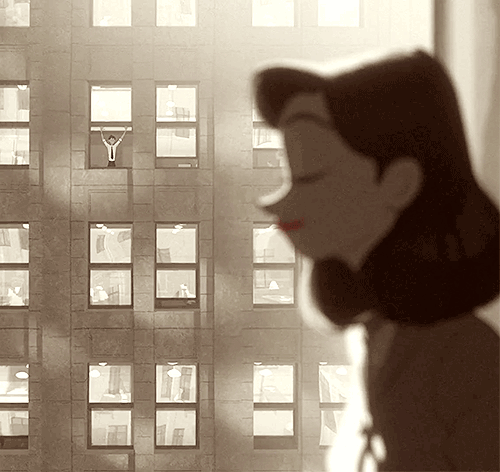
An ominous “ahem” from the boss brings him back inside, and back to his desk. But his attention is still on the girl, and the need to get her attention. He folds a paper airplane, stands before the window, poises the airplane to fly … but he glances at his boss’s office before he throws it. Should he?

6) Break Into Act 2
Yes. Yes, he should. He sends the little airplane messenger to bridge the distance between himself and the girl.
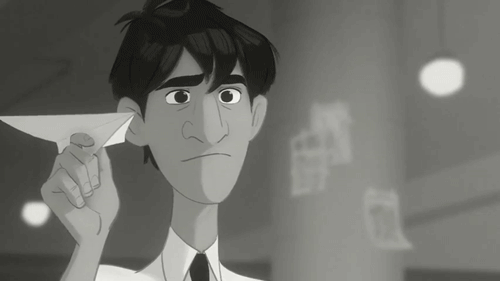
7) B Story
What he should have done while waiting for the train, he’s committed to do now. Talk to her. The relationship of the story has started officially.
8) Fun & Games
In this moment, he becomes the “paper man” of the title. He folds and throws paper airplane after paper airplane. The boss shows up, shoves him back and slams his window. George pauses until he’s gone, then just keeps sending airplanes. They sail over the street, but are intercepted or miss their mark every time.
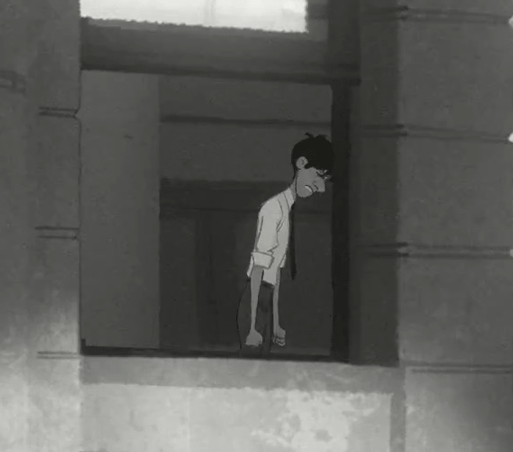
9) Midpoint
He reaches for more paper … and knocks an empty tray off the desk. He’s run out. Except for one paper, the kissed one, the only one he’s held onto. With a determined look, he folds it precisely into an airplane, stands before the window, breathes to steady himself …
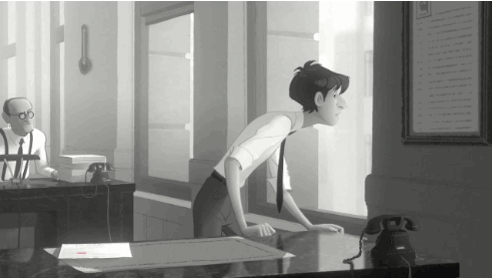
And the wind steals the airplane from his hand, sending it spiraling to the street below, George reaching out pointlessly. On top of this defeat, the girl leaves the office.
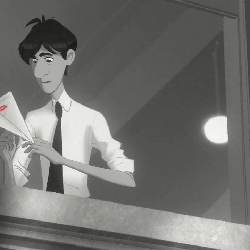
10) Bad Guys Close In
Immediately, the boss emerges from his lair. The other office workers hurriedly return to their scribbling, hunched to avoid drawing attention. The girl is leaving the building across the street! George turns from the window … and finds the boss looming above him, glowering, delivering another tall pile of meaningless work.

George sinks into his chair, defeated. But something happens as he watches his boss walk away, as he sees the office workers in neat rows; all of them older versions of George, reflections of what he will become … if he doesn’t do something right now.
He runs, sending paper from the perfect stacks flying in his wake.

11) All Is Lost
But when he escapes the building, and attempts to cross the street, cars nearly kill him. And when he finally makes it to the opposite sidewalk, the girl is nowhere in sight. She’s lost again.

And all he manages to find is the little traitorous paper airplane. The paper he’d believed might mean something, might have signified something important and maybe a little magical. Which it obviously never did.
12) Dark Night of the Soul
Angry, he grabs the plane and throws it with all his strength. He’s lost his job, he’s lost the girl, he’s lost all faith in the magic he’d just started to believe might be real. He stomps towards the train station, returning home.
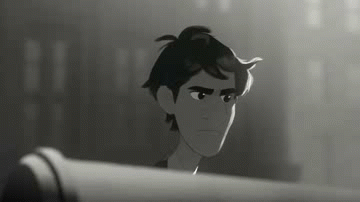
13) Break Into 3
But fate has other plans. The airplane glides over the city, almost supernaturally graceful and purposeful. It dives between buildings, and lands in the middle of the alley where all the paper planes have collected.
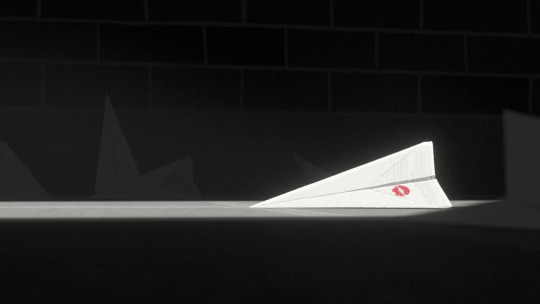
It sits immobile. Then it moves. Moves again. And jumps into flight. The airplane flies over the rest, stirring them into motion, into the air. In a place where not even a breath of wind could reach, there is now a whirlwind of George’s airplanes.

Though the forces of mediocrity tried to keep them apart, something greater has recognized George’s efforts and is going to see things through.
14) Finale
A parade of airplanes follows George down the street.
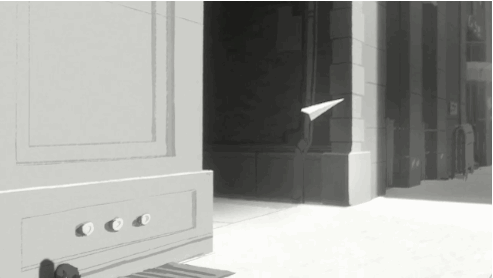
The leader attaches to his leg. He brushes it off, mad. A flurry of them attach to him, then carry him down the street, unfazed by his fighting.

The leader airplane rockets over the city purposefully, finds the girl, then lures her to follow.
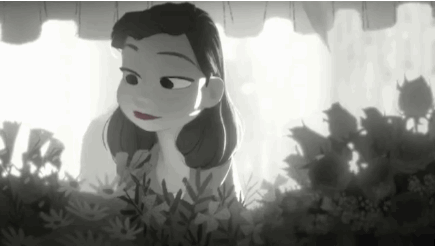
She chases after.
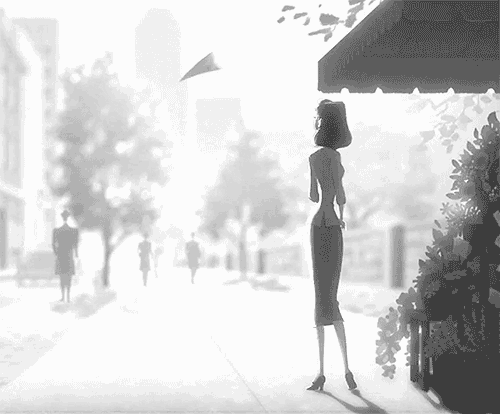
Somewhere else in the city, George is being pushed wherever the paper airplanes want him to go. We switch back and forth between George and the girl, as the airplanes push him and beckon her.
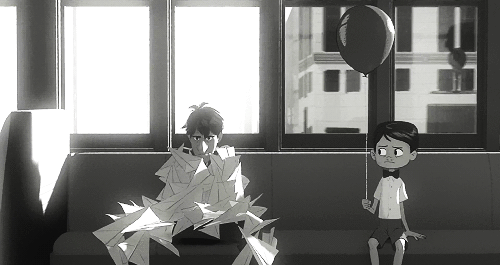
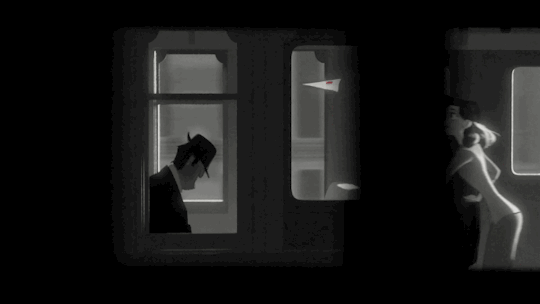
Until they’re both on different trains, which stop simultaneously, on opposite sides of the platform. The girl gets out. She fiddles with the airplane, like she’s trying to get it to work again. And just then, a breeze brings hundreds of paper planes skittering all around the platform.
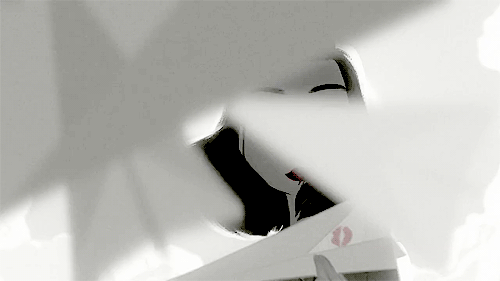
She looks up …
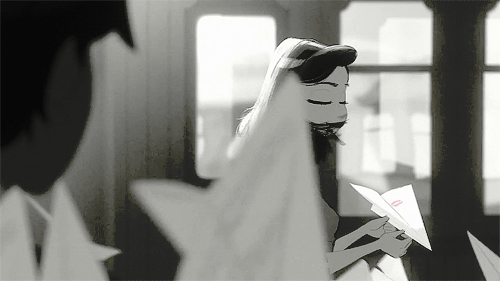
15) Closing Image
And there’s George, covered in paper planes.

He lurches towards Meg, and the airplanes falls away, their work done.
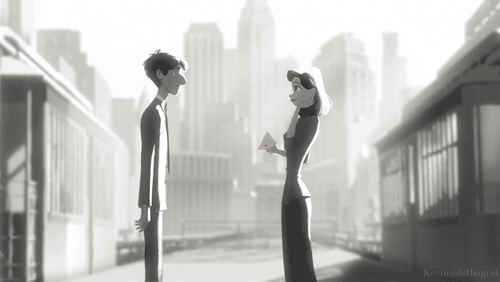
George and Meg face each other, smiling, the barriers of routine and shyness overcome. Exactly what should have happened, exactly what was meant to happen. Putting effort into connection and love prevailed in the end, defeating the allure of life spent in safety and mediocrity. The closing image is the opposite of the opening: he’s not alone, he’s not facing the train leading to his mundane job, he’s not looking miserable and hopeless. He’s facing the girl, his bright and meaningful new future. ***
So! Those are the 15 plot points. This is a fantastic way to begin learning what story structure is, why it works the way it does, and how to precisely pull it off.
For a more in-depth explanation, I highly recommend picking up a copy of Save the Cat. (It holds a special place in my heart; it was the first screenwriting book I ever read, and started obsessive study of storytelling.)
19K notes
·
View notes
Text
A New Writer Is Born
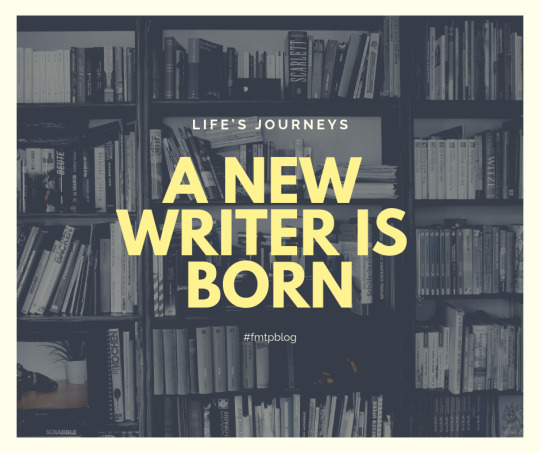
Ah, writing. Such a simple task. You have your characters, know your plot, and created a fabulous outline, complete with various conflicts to work into the story. That’s all you need for this journey…right? When I first dipped my toes into writing fiction, I had no idea what I was doing. I thought I did, as many new writers do, but it didn’t take long to discover just how wrong I was. Writing techniques eluded me, and what limited resources I did have (the World Wide Web was just in its infancy at the time) held various conflicting pieces of advice. To top it off, I had no clue who my audience was, nor had I established a strong voice and sense of self as a writer.
The result? Apart from the fact that I was only a teenager and had limited experience in the field, inevitable failure lurked just around the corner. Broken scenes, random snippets, and straight-up garbage filled each page, because I was clueless about the complex layers needed to make each story worthy of publishing. Revision wasn’t even in my vocabulary, sending me spinning in a never-ending cycle of write, trash, repeat. Since then, I’ve gained considerable experience. I obtained a degree in professional writing, took additional courses in writing, editing, poetry, published a few books, joined a critique group, and have found a writing group full of amazing people going through the same journey. I now know exactly who I am as a writer, and I know that my audience consists of young adults and adults, specifically those who are drawn to paranormal and supernatural stories, coming-of-age books, and emotional women’s fiction pieces. I know I’m a serial writer who loves short stories and hates being confined by genre. For me, falling outside the conventional realm of publishing isn’t the end of the world. It’s what makes me, me. I have my niche, I know my strengths and weaknesses, and more importantly, I’ve learned how to GROW as a writer.
Anyone who’s written a book will tell you it isn’t as easy as it sounds. Rivers of blood, sweat, and tears go into making a good book great. At the heart of every fabulous story is a passionate writer who doesn’t give up. Someone who takes the time to research, prepare, and often plan so many of the details you see on those final pages. And it all starts with knowing your audience. If you don’t know your target readers are, I guarantee you will find yourself in my shoes, spinning in circles, eventually leading you to give up on the book that you’ve been trying to write for ages, or, you’ll produce a piece of drivel you publish way too early, only to find out that you have to start all over.
Don’t make the same mistakes I did. Take the time to find your voice. Get to know your audience. It’s not a race to see how quickly you can publish your book or how many pieces you can finish in a year. Writing is a skill that takes time, practice, and a LOT of dedication. But it’s worth it—you’re worth it. And so is your story.
9 notes
·
View notes
Text
10 Things 2018 Taught Me About Writing
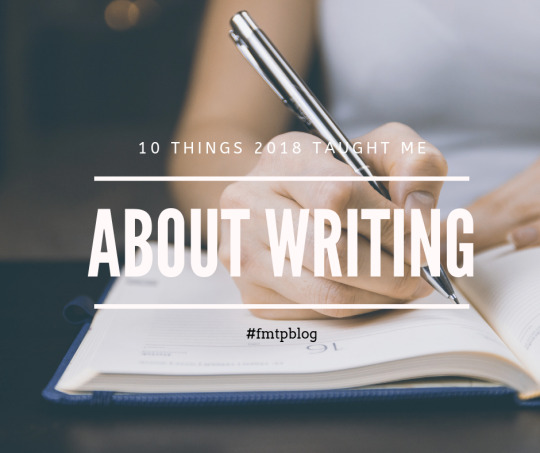
It’s about that time again: Another year has passed—another opportunity to grow and learn who I am as a writer. In many ways, 2018 was my most challenging year yet. I didn’t meet most of my goals, I had unexpected health issues, and I had to step outside my comfort zone on multiple occasions. However, it was also a vastly rewarding year. Amazing new opportunities fell into my lap, I attended a fabulous writing conference, and I was reminded yet again why I love writing so much.
Writing is a tough journey for all of us. I’ve been writing since I was six, and one thing has never changed: Life can and will get in the way. But how you react to life’s trials determines how successful you are. I strongly encourage any writer, no matter how long you’ve been writing, to reflect on what the past year has brought you. You might be surprised how much you’ve grown!
For me, these were 2018’s life lessons about writing:
Writing takes perseverance. Some days, our muse is cooperative and shows up when we need it to. On others, it hoards those much-needed ideas. Stories don’t always hit us full in the face either; they often come in chunks—snippets, scenes, flashes of characters and conflict. And just as with any good idea, those tidbits need time to simmer, giving them a chance to meld. So this year, rather than waiting for my ideas to lead me where they want, I’m go to poke them, prod them, and show them who’s boss. In fact, I’ve dedicated a set number of weeks per stage on each project before transferring it to the next one. That way my mind is constantly churning out ideas and no one project sits for too long.
Burnout is a real thing. As much as I love writing, there still comes a point where I’ve had enough and getting the words down is like prying teeth loose. Don’t get me wrong; I feel immensely blessed to do what I love every day and have a career in it. But all of us need a break sometimes, even from the things we love most. Our bodies need rest and time to recover, giving new ideas a chance to foster. I’m trying to be more aware of that and have even built in two vacation weeks into my writing schedule for the year as well as two months at the beginning of each year to prepare and plan my goals for the next season. Staying focused but allowing time off as a reward is the type of organization I’ve sorely needed since the beginning of my current project, and so far, having that is paying off.
Being bold can boost your confidence. I’ve often spoken about writing what you don’t know but found it much harder to heed my own advice. After organizing my files on my computer, a task I’d put off for years until recently, I discovered a gem: a scene I’d written ages ago that had a narrative voice unlike anything I’d ever written, but in the best way possible. It was a snippet where I’d let myself go in my thought process, allowing myself to be as bold as I wanted in a character’s shoes, no matter if it fit my normal “style” or not. The result was a phenomenal narrative that stood in stark contrast to the pieces I’ve written up to this point. And you’d better believe it’s a tactic I’ll be using in the future.
The more accountability you have from others, the more you’ll push yourself. A few months ago, I took a leap of faith as a writer. I joined a weekly critique group and gained an incredible accountability partner. I wasn’t sure if I’d be able to keep up with everything, but I’m so glad I made the commitment. Both have had a tremendous impact on my productivity, resulting in more words down on the page and more edits completed even when I’m not writing something new. As it turns out, when you have six people expecting you to get something done, you’re more likely to deliver.
Spreadsheets are glorious. In the past, I’ve given myself deadlines, albeit flimsy ones, and I’ve made promises of word counts, release dates, etc. It’s not like I wasn’t on the right track with those steps, but there’s something about visual maps that really gets you in the right headspace for conquering the world—or at least finishing your book. It’s taken me two full weekends to do so, but I’ve created a detailed plan for the entire year. I’ve factored in time for my own writing projects while still accommodating my pre-existing deadlines I have from clients, and I’ve even thrown a marketing plan in there too. I made schedules, timelines, and even a chart to show my progress. And let me tell you, it’s changed EVERYTHING. I’ve been more productive in the last two weeks than I was in the last six months of 2018. Months! I’m sure spreadsheets and charts don’t hold that same kind of power for everyone, but for me, I needed that visualization, the reminder of where I am and where I want to be. Being able to track my progress is such an effective reward that I’m now hitting my goals every week.
Speaking of goals, setting detailed ones (and using apps to help you reach them, such as Todoist) can be a game changer. As I said, this isn’t the first year I’ve tried making a schedule—or using an app to help me. In past years, my halfhearted attempts have always failed when I get overwhelmed by the enormity of the task. (Needless to say, having anxiety really stinks.) But what changed this year was my approach. I didn’t go in expecting the first thing I tried to work. I used a more methodical mindset, trying different spreadsheets and ways to map things, and tossing out things that didn’t help me progress. It took trial and error before I hit on the right combinations, but it’s proven to be a successful endeavor, and I have the numbers to back it up.
I don’t read often enough. After having a miserable 2018 in terms of meeting my reading goals, I picked up a new book called Write Smart, Write Happy that was recommended to me by my editor. It’s motivated me to recommit to both my writing and reading goals, something I know will only help me further in growing in my craft. After all, we can learn a ton from reading others’ work, especially those who write better than us.
My writing muscles are flabby—too flabby. In my latest podcast episode, I talk about how writing is like exercising. Muscles don’t stay strong unless you use them. However, I once again did a terrible job at heeding my own advice, and I found that even writing something as simple as a blog post had become immensely difficult. It was like learning a second language all over again: The info was there, but recalling it was a nightmare. Now I have to rebuild that habit.
Pacing is everything. I didn’t even realize it was a struggle of mine, but as I’ve been editing book three of The Porcelain Souls, my critique group pointed out how my paragraph breaks and the structure of my sentences could be better. And they were absolutely right. Many of the scenes in the current book I’m working on for the series are so intense that they call for shorter, snippier sentences in parts to keep the pace where it should be. So now I know a specific area I need to study more and am adding it to my goal list for the year. I’ve already found a ton of great resources on the topic, including this article on the Helping Writers Become Authors site: https://www.helpingwritersbecomeauthors.com/scene-breaks/
I have a bad habit of making excuses, but even more than that, I’m an expert at psyching myself out. Last year, I became enemy #1 … to myself. I set weak goals that couldn’t stand up to the inner procrastinator in me. I’d see these tasks, and rather than turning them into manageable chunks, I’d let them lord over me as monumental obstacles whose proportions were so overblown they were basically caricatures. Piles upon piles of sticky notes laughed at me (okay, maybe not, but they did clutter my desk). And the idea of finishing the editing process for my book so I could finally publish it? Forget it. But the truth of the matter is, once I actually sat down and worked on something—anything—for just ten minutes, the words started flowing, and it was like I’d never quit. We writers are great at making things out to be harder than they have to be, swearing that we’re not good enough at x, y, or z to accomplish something worthwhile. And I get it; confidence can be a struggle for me too. But as the saying goes, sometimes you just have to park your butt in the chair and WRITE.
7 notes
·
View notes
Text
WDC Series: Villains with Positive Character Arcs
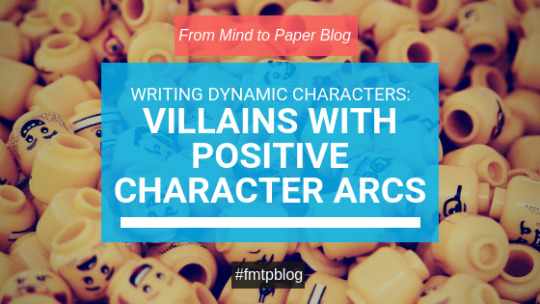
Ah, villains. Quite possibly my favorite characters of all time. They’re swift talkers, fast thinkers, and they earn the best internet memes. Everyone knows who they are. But what really makes these characters special for me is they tend to be complex, holding a depth that protagonists and other supporting characters sometimes lack. (Don’t throw things at me yet—I did say sometimes.)
Truth be told, stellar characters need complexity no matter whose side they’re on. Authenticity, depth, a clear goal, an irrefutable lie, and obstacles make for exquisite layers that form a powerful, relatable, and realistic character.
What Is a Character Arc and Why Are They Important?
A character arc can best be described as the change in a character from the start of a story to the end of it. If a character gains redeemable traits throughout, their arc is considered positive, or one of growth. If there’s no change (which, when done right, will still result in changes from surrounding characters), the arc is considered flat. When good characters go bad, taking on negative traits, that change is considered a falling arc.
One book I love recommending is K.M. Weiland’s Creating Character Arcs: The Masterful Author's Guide to Uniting Story Structure, Plot, and Character Development. In it, she goes into depth about each type of arc and how things like goals, lies, truths, and obstacles are set up in a story. For those of you who don’t want to spring for the book, her website does a great job of providing details about arcs as well: https://www.helpingwritersbecomeauthors.com/write-character-arcs/
Another resource I’d like to share is the Writers Helping Writers site, which has a fantastic article about why writing characters with depth is so important and how that translates to a better book for readers: https://writershelpingwriters.net/2019/01/the-key-components-of-a-compelling-character-according-to-psychology/
As you’ll see in the article, the key is making the characters relatable—not necessarily likeable.
How Positive Character Arcs Can Create Compelling Villains
For those of you who are familiar with my fiction books, you know I love writing unlikeable characters. Their stubborn personas draw me like a moth to a flame, and for whatever reason, creating them has become my little niche, so I proudly wear that badge.
It’s challenging finding new ways to reach readers through darker characters though. One approach I use is taking a complex villain and having them change sides. I do the same with my protagonists. For one, it makes them more relatable. For two, just as in real life, good and evil isn’t always clear-cut. Things get a little muddied in the middle, causing character to cross lines they wouldn’t normally cross. Sometimes really good people make bad decisions, because we’re complex creatures and have the freedom to make choices. My favorite characters are ones who tread in the gray space, because you never know where they stand until it’s too late.
I’ve found when characters hit rock bottom and are in a rut, especially mentally, one of two things will happen: They’ll either pull themselves out and change for the better, or they’ll go down the path of self-destruction. In my current work in progress, The Lost Souls, I have two characters who face such a dilemma. One is faced with extreme loss, and it forces her to take action, ultimately changing her for the better. The other has faced life-altering traumas as well, but he spirals out of control into a deeper pit of anger, revenge, and self-destruction.
When it comes to character development, characters can change as much as people can (which now has me humming “Hot N Cold” by Katy Perry), and sometimes those changes result in positive character arcs—think Ebenezer Scrooge from A Christmas Carol or Hans Solo from Star Wars. Whether you’re dealing with a protagonist or an antagonist, combining complex traits with a transformative arc can yield captivating results, especially when those characters are less than likeable.
6 notes
·
View notes
Text
Last month, I got an opportunity to participate in @kiramartinauthor‘s First Sentence Friday critiques, and I had a blast! I just wanted to give her a shout-out to say THANK YOU and to encourage you guys to submit your first lines to her for a fresh perspective and great feedback on how you can tweak them to be even better. :)
10 notes
·
View notes
Note
i've been writing a book and the feedback i've gotten from family members is that i have been using a lot of description, that the plot is moving along pretty slowly, and "something" needs to happen. do you have any tips or advice on moving plots along quicker in order to keep the reader's attention? thanks so much!!
How to Move a Story Forward
When your character is just milling about in their world describing what they see, what they’re doing, and what’s happening to them, that’s not really a plot. It’s just a random string of events happening to your character, and typically it doesn’t make for very interesting reading. This kind of story moves slowly because nothing’s actually happening. Imagine following an average person through their average day versus following Katniss Everdeen through day three of The Hunger Games. It’s a big difference. And that’s not to say every plot has to be as exciting or dramatic as The Hunger Games, but there does need to be a conflict.
So, the first thing you have to do is sit down and figure out what your story is really about. What is going on in this person’s life that is worth writing about? Is there some sort of inner conflict they’re struggling with? Or is there an external conflict of some kind? Usually there are both with the focus being more on one than the other.
How stories begin…
Most stories start when a character’s life is still normal but just about to change. Katniss was getting ready to go hunting with Gale. Bella was settling in at her new high school after moving in with her dad, and Harry Potter was just living life as the boy in the cupboard.
What happens next…
And then something happens. This is called the “inciting incident” because it “incites” the conflict and brings on the important events of the story. Katniss volunteers as tribute when her sister is drafted into The Hunger Games. Bella meets Edward Cullen and an instant attraction develops between them. Harry Potter receives his letter to Hogwarts.
The character responds and forms a goal…
The character’s normal life has been turned upside down. Now what? For Katniss, the most important thing in the world to her was the safety and well being of her sister and mother, and since she is the one who keeps them safe and fed, her survival of The Hunger Games is vital. That’s her motivation, and her goal is to win the game. Bella becomes obsessed with learning more about Edward and who, or what, he is, and she falls for him and the magic his world brings into her otherwise boring life. Being part of that world is her motivation, staying alive in the process is her goal. Harry finally has a ticket out of his life of being abused and unloved, and he has a chance to connect with the legacy his parents left behind. Leaving his old life behind and embracing this new one is is motivation. Surviving his first year at Hogwarts is his goal.
But goals aren’t supposed to be easy to reach…
If the character can just sail smoothly right up to their goal, mission accomplished, that makes for a pretty boring story. You never hear people say, “WOW! THAT WAS AN INCREDIBLE GAME!” when the score was 20 to nothing. What makes the game exciting is when the teams are neck and neck, one getting ahead for a little while, then the other one being ahead for a little while. It’s the trying, and often failing, to get over obstacles that makes the conflict more interesting. In a lot of ways, that struggle actually is the conflict. What obstacles stand in the way of your character and their goal, and who (or what) put them there? For Katinss, the obstacles were the other tributes and all the frightening things added to the game by the gamemakers. For Bella, it was the nomad vampires who caused trouble at first for fun, and then later for revenge. The obstacles Harry faces are partly due to conflict with other students and teachers, and partly due to the first “shots fired” in what would become the overarching battle against Voldemort.
You win some, you lose some…
And it’s important that you show some wins along with the failures. Sometimes the character tries to overcome an obstacle, fails, tries again and succeeds. Sometimes they fail and have to come up with a work around. Either way, the fails add to the tension and drama while the wins add excitement and interest in what happens next.
The final showdown…
Eventually you get to the big showdown, aka “the climax.” This is when your character faces down the biggest challenge that stands in the way of reaching their goal. This could be an epic battle between your character and the villain. It could be the moment where your character realizes they’re in love with their best friend and they chase them to the airport to admit their undying love for them before they move away. Or it could be surviving one last night of a terrible storm before crawling out of hiding to assess the damage. Whatever it is, the culmination of that moment is achieving or failing to achieve their goal.
The dust settles…
Whatever crazy chain of events was set off by the inciting incident, they’ve come to an end now thanks to the actions of your protagonist and their friends. Or, if they haven’t come to an end, they’ve at least been waylaid for now, or things are at least moving in a better direction. Now your characters can clean up, rebuild, mend wounds, tie up loose threads, and get back to life as normal. Or, in the case of a series, they can re-group and figure out what happens next. And that’s the end.
… But some stories happen on the inside.
Some stories are more about people and their experiences than about any big crazy thing that happens to them. Stories like these are more emotional and are more about dealing with the inner conflict than an outer one. But even in stories like these, you’ll still have a similar structure to what I laid out above. It’s just a lot looser and tied up with an emotional journey rather than the physical one. Which isn’t to say they can’t have a parallel physical journey, but the important stuff is happening on the inside.
Whichever kind of story you’re writing, if you make sure you’re hitting the important points I’ve laid out above, whether they relate to an internal conflict, an external conflict, or a little of both, you can be sure you’re writing a story that is moving forward and will keep your audience engaged. Everything I’ve outlined above is the “something” that needs to happen to make your story interesting.
Good luck! :)
873 notes
·
View notes
Text

⇢⇢⇢⇢⇢⇢⇢⇢⇢⇢⇢⇢⇢⇢⇢
Rachelle Shaw
⇠⇠⇠⇠⇠⇠⇠⇠⇠⇠⇠⇠⇠⇠⇠⇠


An avid reader and grammar fanatic, Rachelle Shaw (@fmtpextended) has lived and breathed writing for as long as she can remember.
She started journaling at the age of six and was writing short stories by eight. Later came poetry and novellas. After graduating from Purdue University with a degree in professional writing, she spent several years working as a technical writer, copy editor, and layout artist before branching out on her own as a professional editor. She’s now been at it for over seven years and loves her job.
Her publications include the YA short story horror series The Porcelain Souls and the women’s fiction short Sisters. She’s also contributed several articles to the 10 Minute Novelists website. She’s currently working on the third, fourth, and fifth installments in The Porcelain Souls series as well as another women’s fiction short and a nonfiction series about the craft of writing. She always has a need for more beta readers and ARC reviewers, so if you’re interested, please message her!
When she’s not busy writing or editing books for others, you can find her blogging, working on her podcast, or plotting her next series. By day, she’s a stay-at-home mom to two wonderful kids and a rather persnickety cat. By night, she’s an incredibly ambitious (and sometimes zany) artist who has way too many projects and secretly loves building snow furniture.
WEBSITE ◘ PODCAST ◘ FACEBOOK ◘ TWITTER ◘ TUMBLR ◘ INSTAGRAM
⇢⇢⇢⇢⇢⇢⇢⇢⇢⇢⇢⇢⇢⇢⇢
BOOKS
⇠⇠⇠⇠⇠⇠⇠⇠⇠⇠⇠⇠⇠⇠⇠
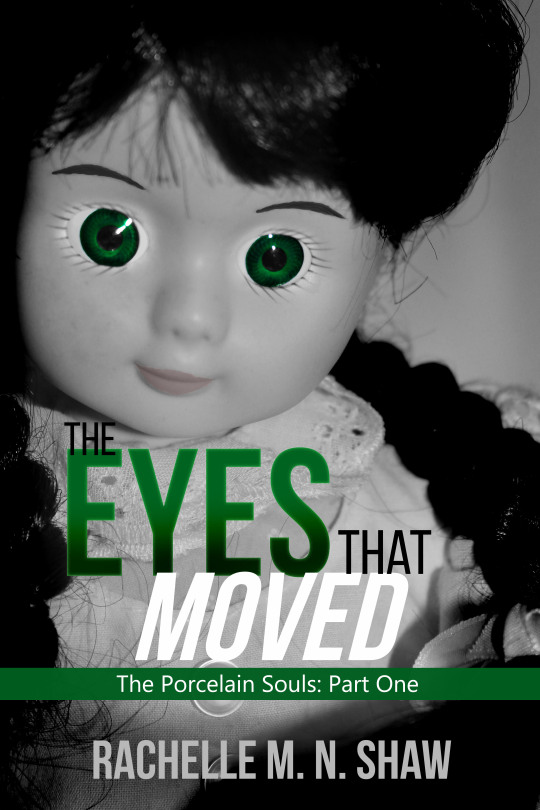
The Porcelain Souls #1 - The Eyes That Moved (free at most major online retailers)
Kendra Merrick has a knack for spotting unusual trinkets and treasures, and she isn’t afraid of using unconventional—or illegal—methods to obtain them. When she meets Adam, a fellow sleuth and collector, they embark on their biggest adventure yet: the Whitson house. The house is a marvel, and its secrets are even stranger than she imagined.
Kendra stumbles upon the find of a lifetime. But she may have signed on for more than she bargained. There’s a darkness in the house that wasn’t there before, a pair of eyes in every corner, watching, waiting. And Adam isn’t at all who he claimed to be.
In this chilling tale with a unique twist on paranormal horror, one girl learns just how deadly porcelain dolls can be.
AMAZON ◘ iBOOKS ◘ BARNES & NOBLE ◘ GOOGLE PLAY
⇢⇢⇢⇢⇢⇢⇢⇢⇢⇢⇢⇢⇢⇢⇢
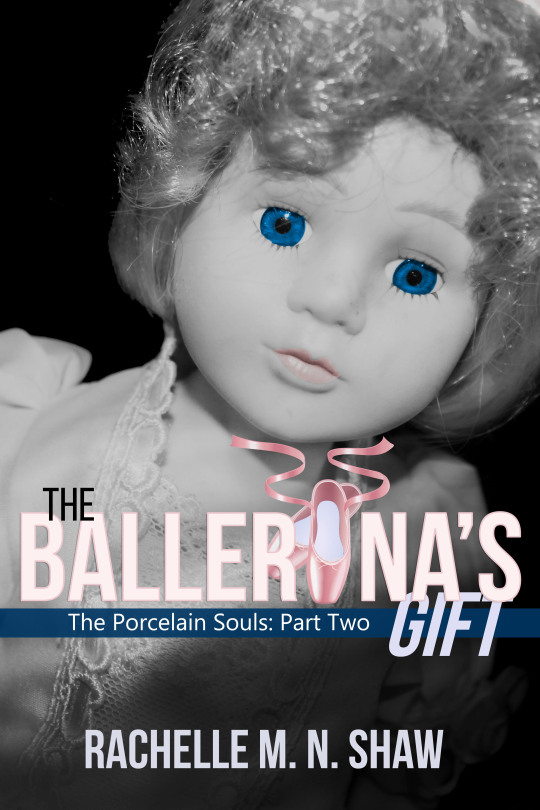
The Porcelain Souls #2 - The Ballerina’s Gift
Marley Harcove wants nothing more than to inch her way up the social ladder and win over her three-year crush. But after her parents buy the infamously spooky Whitson house, she comes face-to-face with the rumors surrounding it—and one of its previous occupants.
When her rival, Alex Wingate, crashes her party, everything unravels. Marley needs a plan, and fast, especially after whispers of a missing girl spread and an anonymous gift turns up in her bedroom. But those are the least of her concerns. If rumors about the house are true, more than Marley’s reputation might be at stake.
In the hair-raising sequel to The Eyes That Moved, more souls hang in the balance, leaving their captor with a burning vengeance to complete his collection.
AMAZON ◘ iBOOKS ◘ BARNES & NOBLE ◘ GOOGLE PLAY
⇢⇢⇢⇢⇢⇢⇢⇢⇢⇢⇢⇢⇢⇢⇢
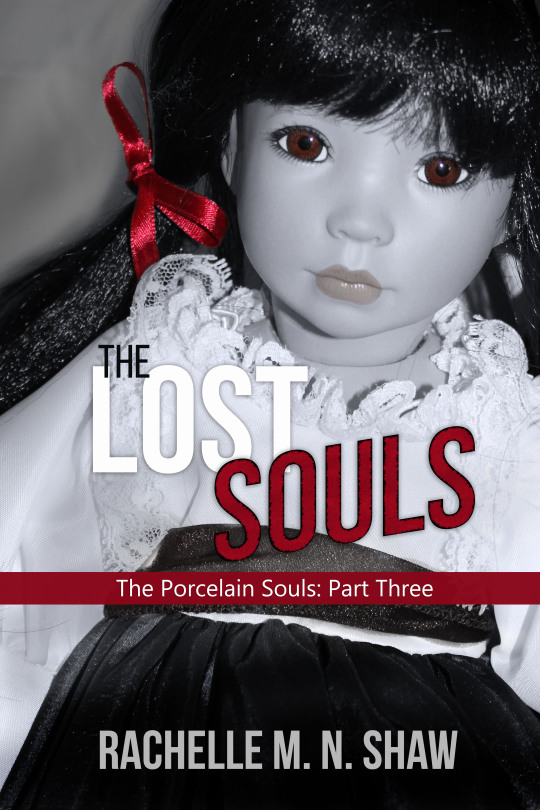
The Porcelain Souls #3 - The Lost Souls (WIP)
A dead cop and a string of mysterious disappearances set the town of Credence on edge. Despite the growing dangers surrounding the Whitson house and the chilling warnings left by her ancestors, Huiliang Zui risks ties with her family and breaks into the abandoned building to find answers. But the tortured spirit residing there demands blood, seeking to eradicate his past life’s miseries and complete his collection.
When Alex Wingate helps Huili out of a tight spot, an unexpected friendship forms. However, it isn’t long before old wounds resurface and motives are questioned. Can they overcome past judgements and work together to destroy the demon? Or will they, too, fall victim to his trap and perish like the lost souls before them?
In the latest installment of The Porcelain Souls series, the fate of Credence rests on one girl’s shoulders. If she fails, they’ll all be devoured.

⇢⇢⇢⇢⇢⇢⇢⇢⇢⇢⇢⇢⇢⇢⇢
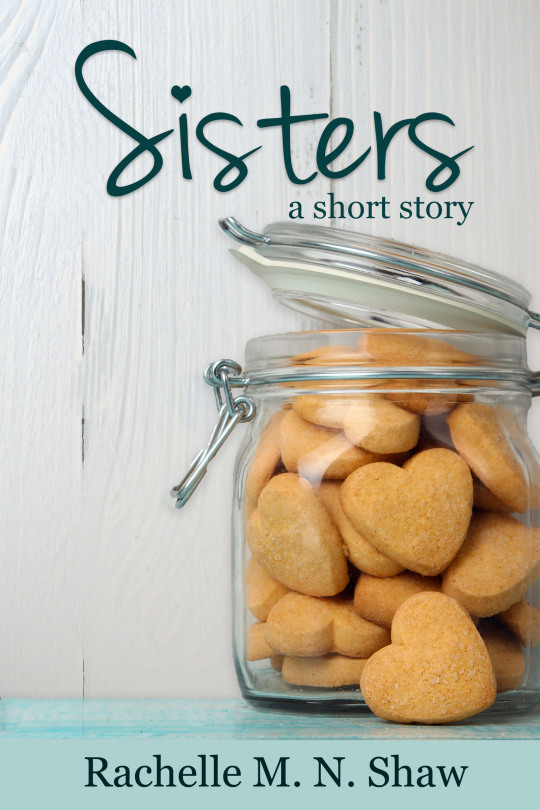
“Sisters” short story
When tragedy strikes in the lives of two young girls, claiming the life of their father, envy takes hold. Childhood memories fade, and spite replaces the once immovable bond between Matilda and her sister, Charlotte, as the years go by. One settles for a traditional life with her husband and kids, burying the punishment and shame of her past, while the other cultivates a career set in the early days of feminism, pursuing work as a nurse during the birth of World War II.
Both spend their days reveling in a façade of happiness. But after reality strips away their youth and they face the onset of another era, tainted wounds still mark their hearts. Are family ties enough to overcome life’s arduous trials?

AMAZON ◘ iBOOKS ◘ BARNES & NOBLE ◘ GOOGLE PLAY
……………………………………………………………….
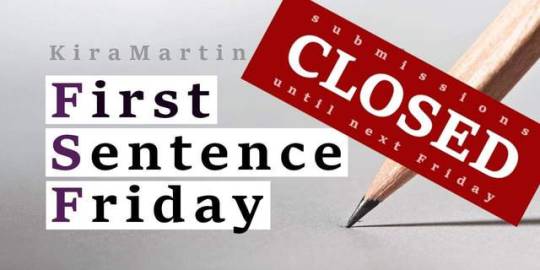
Submit your first sentence this Friday to get not one, but two perspectives on your work!
If you’re interested in being guest spotlighted for WW & FSF, read this post and shoot @kiramartinauthor a message!
15 notes
·
View notes
Text
An Easy Way to Improve Your Writing: Be Truthful to Your Experience

Whenever you’re writing a scene, take a second to forget how you’ve (painstakingly) planned for it to go, or whatever has come out of the top of your head in the moment, and ask yourself: am I being truthful to this experience?
As writers, sometimes we want to write out our idealized version of an event, just so it exists somewhere. Sometimes we want to move from Point A to Point B as quickly as possible. Sometimes we just aren’t thinking about it.
And that means we write a scene that at worst will make a reader groan with frustration at how unrealistic the writing is (and we’ve all wanted to throw books across the room because of this before) and at best just isn’t living up to the potential of what literature can offer a reader.
I love writing about the autumn. I like it when mornings are foggy and the leaves crunch beneath my feet and cool breezes cut through the last of the summer’s heat and there are pumpkins smiling at me from porch steps. I want to bring that into my writing. But that’s how autumn is in my mind. It’s not truthful to my experience of autumn.
Every year without fail, throughout the entirety of September and October, I wear sweaters when it’s just not cold enough yet, and end up sweating through my clothes underneath them, which leads to a no-win situation: do I take my sweater off and cool down, revealing how gross it’s already made me? Or do I suffer through it while searching for the nearest A/C? It’s a never-ending autumnal dilemma.
While I can—and will—put all of the things I love about autumn in my book, I’m not writing an autumn that’s truthful, that’s representative of life as I’ve experienced it, unless I put in a moment where my protagonist wears a sweater on a day that’s far too hot for a sweater. Not putting it in is bad for my writing for a number of reasons.
For a start, I’m losing a chance for my reader to relate to my main character and think “Oh god! That happens to me, too!” Readers love those moments. Those moments are a chance for my reader to connect with the protagonist and the book itself. As a writer, I shouldn’t miss opportunities for them.
What’s more, I’m losing the potential for a bit of tension. A plot isn’t a series of perfect days. A book should be full of conflict and discomfort for a protagonist. If I add this moment to a day when my protagonist is fighting with their best friend, being chased by evil villains, or worst of all, seeing their crush for the first time in months, I can make everything just that much harder for them.
If the moment isn’t one of tension, it’s just as important to include moments of emotion or humor or whatever else may have been missing from that scene.
This doesn’t mean there can’t be a perfect autumn day in your book. Or that a situation can’t become weird and fantastical, but unless there’s a narrative reason (other than convenience) for things not happening realistically, even the scenes that are supposed to read as unrealistic aren’t going to have the impact that they should, because there’s no realism to compare them to.
So when you’re writing, ask yourself:
Would the person they’re talking to really let them get away with that comment?
Would their friend agree to the plan so easily?
Would my protagonist really just shrug that off?
Would their grandma let them escape without making them take home three plates of cookies and one of those ancient hard candies?
Would the bus stop be so close to their destination?
If the answer is “no,” rewrite the scene and I promise your book will be better for it.
2K notes
·
View notes
Photo

So, so many works I’ve read could be vastly improved with tightening and shaving of superfluous words. Wordiness is an easy stumbling block, as we’re used to how we talk. We’re used to how others (long ago) wrote. But times change, my friend, and so do expectations of the writer. We don’t get paid by the word in fiction. So show your smarts and say as much as you can with as much power as you can in as few words as possible.
Here are a few things you can cut without reserve to help shorten your story right now. And as you catch yourself using these words in your next draft, hit that backspace before you finish the sentence! It’s okay if you already have. You can go delete them now. No one will ever know.
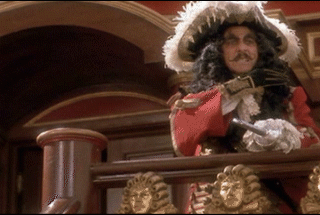
Moment/Second/Minute
It’s so tempting. I am guilty of using this word like fertilizer in my first drafts. But most of the time, these words aren’t needed at all. They add nothing.
He sat down for a moment, sipping his coffee. vs. He sat down and sipped at his coffee.
But he only did it for a moment, you say!
He sat down for a moment, sipping his coffee. When the door opened a second later, he shot to his feet. vs. He sat down and sipped his coffee. The door opened, and before he could swallow his first sip, he shot to his feet.
I know, this is about making your writing more concise and my “right” example has more words than the first example. But what’s the difference? The words used in the second sentence are more tangible. They give a visual that “a second later” and “for a moment” don’t. And you could leave that part out, of course, if you’re really going for trimming word count. It doesn’t paint quite the same image, but “The door opened and he shot to his feet.” is a perfectly good sentence.
Suddenly/All of a sudden
You’ve heard this one, before, surely. These words are used…when? When you’re trying to portray suddenness. Surprise, perhaps. So why are you adding in extra words to slow down the pace?
She flipped on the TV and reclined in her chair. All of sudden, the TV flashed a bright light and the power went out. vs. She flipped on the TV and reclined in her chair. The TV flashed once before the lights went dark. The power was out.
That sense of immediacy is felt when stuff just happens. So let it happen. If it’s rhythm you’re worried about, then find more useful words to create the rhythm. Notice that I didn’t just cut “All of a sudden” out of the sentence and leave it. I reworded it a bit to make it stronger.
Finally
It can be a useful word, but more often than not, it’s just taking up space.
Really/Very
Just…delete them.
To alter a Mark Twain quote:
“Substitute ’[fucking]’ every time you’re inclined to write ‘very;’ your editor will delete it and the writing will be just as it should be.”
But seriously, if you’re saying, “She was breathing very hard.” You could just cut the “very” and say, “She was breathing hard.” Or, even better, “She was panting.” Or, EVEN BETTER: “She panted.”
Himself/herself/myself/themselves
Reflexive nouns have a specific purpose, though they can still often be avoided. They fall into the category of “use only when it’s confusing otherwise.”
Correct: He looked at himself in the mirror. Better: He looked in the mirror.
Incorrect: She gave them to Andrew and myself before leaving. Correct: She gave them to Andrew and me before leaving.
Technically correct I guess: I haven’t eaten lunch myself. (Intensive pronoun; aka waste of words) Better: I haven’t eaten lunch.
Intensive pronouns add emphasis, but that emphasis is negligible and often negated by the power of tightening your narrative.
That
You can likely cut 60% of your “that"s and your story will be unaffected. Sometimes, you do need to add a “that” here and there for clarification, but not always. And sometimes it’s just plain incorrect.
The jacket was the coolest one that he’d ever owned. vs. The jacket was the coolest one he’d ever owned.
In other cases, you might do well to substitute “that” with “which.” Though, if you’re doing this, make sure you do it properly. That change can often alter the meaning of your sentence. That can be for the better, though.
The vandalism that read “Bad Wolf” made Rose nervous. vs. The vandalism, which read “Bad Wolf,” made Rose nervous.
Do you see the difference? In the first sentence, the words are what make Rose nervous. In the second, the vandalism itself makes Rose nervous, and it happens to say “Bad Wolf.” In this case, if you’ve watched Doctor Who, then you know the first example is the correct one.
So when you’re sharing details using “that” or “which,” contemplate how important they are to meaning of the sentence to determine which type of clause you need to use.
Then
Or worse, “And then.”
It makes your writing sound a bit juvenile. Either cut it entirely, or substitute “and.”
She jumped into the pool, then hit her head on the bottom. vs. She jumped into the pool and hit her head on the bottom.
And then, after all that time, she fell asleep. vs. After all that time, she fell asleep.
Even
Sometime “even” can help emphasize a situation or behavior, but when it’s used in narrative improperly, it sounds childish and silly.
He couldn’t even breathe. vs. He couldn’t breathe.
Even with the new hair gel, his hair was terrible. (This one is fine, though you could still cut that “even” if you really wanted to…)
Just
Just…Delete it.
Breathe/breath/exhale/inhale/sigh/nod/shrug
Another one I’m so guilty of. In my first drafts, I tend to talk about how a character is breathing, or when they’re sighing like nobody’s business. I know a lot of writers who are guilty of this, too. It’s a great tool to use scarcely. In intense moments, you can let your character take a final deep breath to calm themselves. When a character almost drowns, those first few sweet breaths are important. But you readers know that people breath all the time. And just because you need a beat in your dialogue doesn’t mean you need to remind your reader that the character is still breathing or moving.
Rather/quite/somewhat
She was rather tall. She was tall. He was quite idiotic. He was idiotic. They were somewhat snazzy. They were snazzy. Why do you need those words? Kill ‘em.
Start/begin
This is a great example of fluff.
She started to run toward the shop. vs. She ran toward the shop.
He began scolding them for their performance. vs. He scolded them for their performance.
There are obviously uses for this word, like anything. He started the car. Begin your tests! But when you’re using it to slow the action and the pace of your narrative, then consider heavily if you need it. You probably don’t.
In order to/in an attempt to
Phrases that add unneeded complications, cumbersome wording…kill ‘em!
She bit down in an attempt to stop herself from screaming. vs. She bit down to stop herself from screaming.
Was able to
He was able to call. vs. He could call. OR He called.
This is one that isn’t inherently bad, but it can easily be overused and cutting it will help simplify your narrative.
Due to
Ugh. Are you trying to sound proper and stuffy? Because that’s a reason, I guess, to use this phrase…and yet it sounds like doodoo. (Yes. I’m an adult.) Rephrase. Use “Because of” or just avoid the need altogether.
We stopped due to traffic. vs. We stopped because of traffic. OR (Strength of narrative!) We stopped mid-highway. The parked cars went on beyond the curve of the road, out of sight.
Visibly/obviously/apparently/audibly
These are a sign of telling in your narrative when you should probably be showing.
She was visibly shaking. –> She shivered, hugging her upper arms. He was obviously tired. –> He yawned and tripped on his own feet as he crossed the room. They were apparently angry. –> They stomped and shouted, demanding attention. She screamed audibly. (Really?) –> She screamed.
Don’t tell your readers what emotion a character is feeling. Instead, give a few clues that they can see/hear/feel the emotion too.
While
This word has lots of legitimate uses. However, if you’re using it poorly, then your narrative reads like an Early Reader’s book, and you (unless that’s what you’re writing) probably don’t want that.
“Get it together,” he said while flipping them off. vs. “Get it together,” he said, flipping them off.
Turned
One of the classics. So overused, my friends. It’s needed on occasion, but not nearly as often as we use it. Just cut it out.
They turned toward her as they spoke. vs. They gave her their full attention as they spoke. OR They looked into her eyes. OR (Nothing. Readers don’t have to be updated on every little movement.)
Saw/looked/regarded
UGH. Regarded:Looked::Mentioned:Said
And, like “said,” many, many instances of these words can be nixed.
She saw them run for the hills. vs. They ran for the hills.
This can be tricky, I know, when you’re writing in limited-third or first POV. It’s tempting to put every action directly through your POV character’s filter. But resist that temptation! There are times when it’s appropriate, occasionally, but it can be overdone so easily.
I looked at her and said, “Please.” vs. I said,“ Please.” OR. I took her hand. “Please.”
This example sides with the breathing and the turning. It’s often an unneeded update on the tiny movements of the characters. And, again, sometimes you need that beat or that little detail in an intense moment, but not often.
Said/replied/stated/spoke/mentioned/asked/commented/yelled/cried/shouted
I’m not here to tell you to cut all your dialogue tags (please don’t). I’m also going to the last person who insists you get rid of “said.” In fact, I’m in the “said is invisible” party of writing nerds and I think, if you’re going to use a standard tag, it should be “said” 90% of the time.
But aside from that, using as few dialogue tags as possible is a good thing. I’ll do a full post on this soon, but for now, be aware of how often you rely on these words in your dialogue and do your best not to overuse them. Use surrounding action and context to take some of the reliance off of these words.
To-Be in all its conjugated forms
If you’re using any of this list:
am, is, are, was, were, be, being, had been
Then check yo'self. Some tenses call for an auxiliary verb. Some types of sentence do, too, not doubt about it. But many don’t, and cutting to-be verbs when you can will help tighten your writing.
We were going to the store. vs. We went to the store.
Sounds were echoing through the chamber. vs. Sounds echoed through the chamber.
To-be verbs can also be an indicator of passive voice, though they aren’t always.
He was hit by the ball. vs. The ball hit him.
Last but not least, check all of your adverbs.
Chances are, if you’re using an adverb, you could be using a single strong verb instead and giving each sentence more punch.
He ran quickly. –> He sprinted. I hit him hard. –> I socked him. She spoke quietly. –> She whispered. They ran into each other fast. –> They crashed.
So what am I supposed to do about this?
Take it to heart. Try not to let these words take over your brain as you write. Once your manuscript is finished, try this method:
Use Find and Replace. Replace any and all of the aforementioned words in ALL-CAPS. Now, if you’ve paid attention to my advice in using emphasis, then those all-caps will really stick out as you’re reading over your work and you can decide at each instance whether your usage is appropriate, or if it needs to be rewritten. As I did to this very old draft of mine from my first NaNoWriMo (in which I used every single word on this list, I’m sure).

When I used this method with my most recent WIP, I was able to cut my word count from 105k to 93k without cutting any content whatsoever. It takes a lot of work and it’s pretty tedious but the results are amazing!

It wouldn’t be the English language without exceptions, would it?
Now, there is actually an important time for intentionally using any or all of the words on this list. You know when that is?
When it fits the character’s voice. - More on this in my next post!
24K notes
·
View notes
Photo
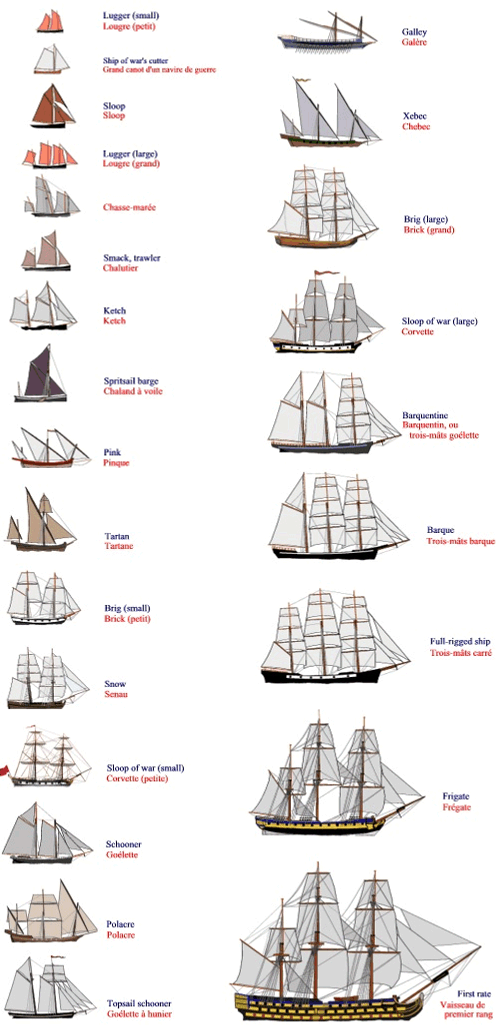
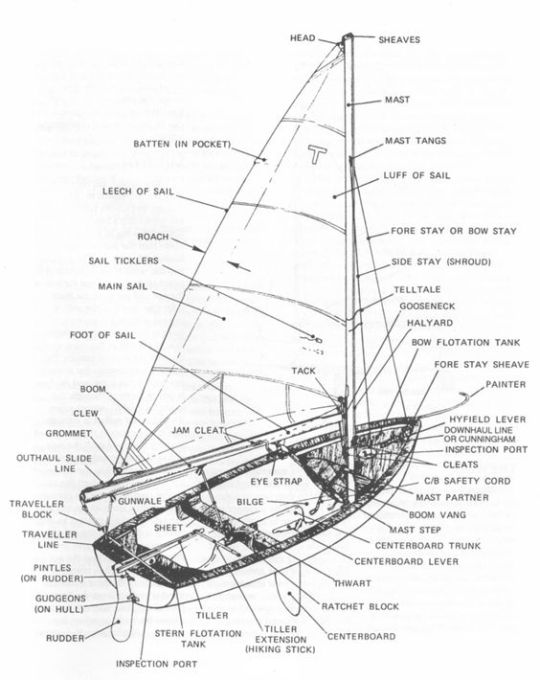
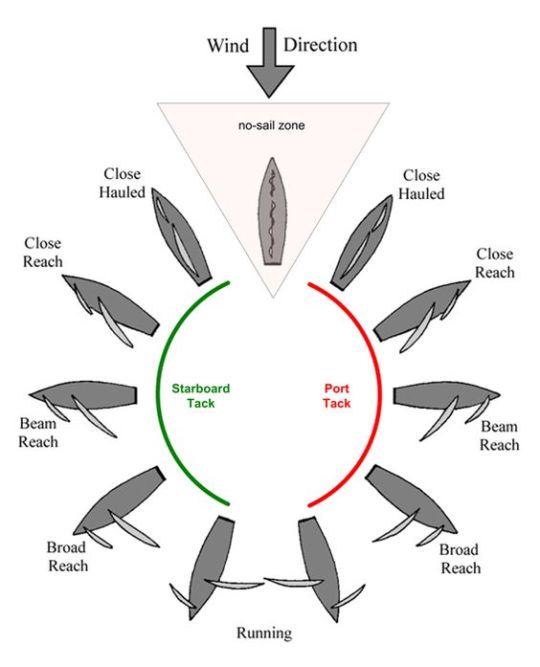

Types of Ships
Parts of the Ship
Wind Directions
Sides of Boats
63K notes
·
View notes
Text
Holiday Book List 2018
Hello Writeblr, Readblr, and Bookblr. Its the day some of you have been waiting for! The Holiday Book list~ In case you haven’t heard - this list is a compilation of books written by our very own writeblr authors!
I encourage you to purchase books you would be interested in, and please leave a review or star rating for the author. You will make their day!
If you don’t have the funds to purchase a book, don’t worry! We have a few freebies down at the bottom!
The list is organized by least reviewed first.
Keep reading
163 notes
·
View notes
Text
Friendly reminder that writing advice is subjective. Even I’ve given out advice that I later realized was poor or in bad taste. When looking for help with writing, try not to take everything so literal. If it rubs you a wrong way, it’s okay not to follow it. The thing about writing (I’ve said this before and I’ll say it again) is that it’s a never-ending learning process, even for the people giving out the tips and advice.
57 notes
·
View notes
Text
Such a fabulous idea!
Writeblr/Readblr Authors and Readers READ THIS PLEASE
Guys I just had the craziest idea ever.
This writeblr community is all about helping each other. So… let’s REALLY help each other out this holiday season in the atmosphere of giving~
I want to post a list of the published books from the authors in the writeblr community.
I will put the least reviewed/purchased books at the top of the list. I will post the book title, the genre, the length, the price, a link, and the summary. (So please provide all this information) in a nice organized list. ALL LENGTH BOOKS ARE WELCOME. PLEASE ONLY SUBMIT ONE per author so that everyone gets a chance to have their book bought.
(I also want to do a free section. Do you post your stories publicly to tumblr? To your website? Provide all the same information, minus the price).
Guys, gals and gentlethems, I ENCOURAGE YOU to purchase a book from the list (when it is published) I also ENCOURAGE YOU to leave a review, even just a star rating. I understand not everyone has money to spend, but if you have a couple dollars to spare you could purchase a cheap ebook and leave a review, and trust me, you will make that author’s holiday season.
I may create a page on my blog for this so that it is static, but we will see.
PLEASE. Submit to me via Message or Ask your published book, a link to purchase, the price of the book (if it is more than a few dollars, consider running a holiday promo where you discount the price? to encourage more purchases?) the genre, the approximate length, and a sweet little summary.
Let’s give those underappreciated writers, those who have worked hard, poured blood, sweat and tears into the work a chance to see some reward from their efforts.
The DEADLINE TO SUBMIT YOUR PUBLISHED BOOK IS NOVEMBER 20TH
I am tagging this and all related posts as “Holiday Book List 2018″.
I think you may be interested / ask that you share this please: @abalonetea @writeblrs @thewriteblrchronicles @cometworks @writings-of-a-narwhal @drowsy-quill @jess—writes @notanotherhour @shewhowalksbehindthewheels @writersloth @behrtimestories @adie-dee
496 notes
·
View notes
Text
Why Good Writing Matters: Internal Consistency
This is the final blog post in my “Why Good Writing Matters” series. My husband gets credit for the idea on this one. His profession is pretty much the complete opposite of writing, but he always holds great insight in the field nonetheless. One of the many reasons I love him! Now, onto the good stuff… Have you ever read a book that had a great plot, intriguing characters, and a distinct voice but lacked consistency throughout? If so, did it irritate you and ruin the book for you, or did you view it as no big deal? This may not be the case for everyone, but stories that lack internal consistency—that is, they have plot holes or material that contradicts some other part of the book—really grate on my nerves. In my brief research mentioned in the introductory post for this series, I found this topic held the most disagreements. Some readers weren’t overly bothered by inconsistencies, and others equated them to blasphemy, ruining an otherwise perfectly good book. There was also a spectrum of opinions in between. Where people stood within that spectrum depended on the type of inconsistency and the frequency of it for any given book. That just goes to show, there’s a lot of gray area with this one. I’m not certain only a few minor inconsistencies are enough to deem an otherwise well-written book garbage. However, there are a few things regarding internal consistency that really do matter. These are the things that your readers will pick up on and remember even after they’ve finished the book.
Keep reading
8 notes
·
View notes
Text
How NOT to Start Your Novel
Morning routine that is mundane TO THE READER. Nobody cares how long your main character showers or what their favorite kind of cereal is. Only start your novel with your main character’s morning routine if it is something that isn’t routine to your reader. Does your MC have to steal their breakfast? Include that! Does your MC feed their dragon at the crack of dawn? That’s interesting! Do they spend way to long deciding what to wear? Nobody cares. That’s boring.
A dream. Readers will feel cheated when they read a bunch of interesting stuff only to find out none of it was real.
Excessive world building. Fantasy novels are especially prone to falling into this trap. Little bits of world building that are naturally woven into the narrative are fine. Info dumps are not. Remember, the purpose of the first chapter is to introduce the MC and get the reader invested in what will happen to them, not to give the reader a history lesson about a world they have no reason to care about yet.
Too long before the main conflict. While you don’t necessarily need to dive straight into the main conflict, you shouldn’t keep the reader waiting for it to start for too long. I suggest laying the groundwork for the main conflict in the first chapter and maybe hinting at it directly. That will help the plot get going at a good pace.
Without anything to ground the reader in what’s going on. The reader needs some time to get invested in the main character. While starting in medias res can work, you need to help your reader why they should care about what’s happening to the MC. Otherwise, you might as well be jingling keys in the reader’s face. Be especially careful about starting your novel with a chase scene or a battle since those can be disorienting and might not make it clear why the reader should be rooting for your MC specifically.
Without showing why your reader should care about the MC. Your MC should be one of the main things that keeps your reader hooked throughout the novel. If your reader doesn’t feel invested in them by the end of the first chapter, then there’s a good chance they won’t keep reading.
7K notes
·
View notes
